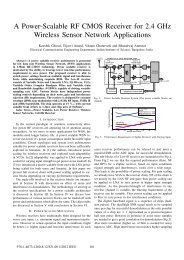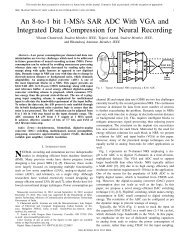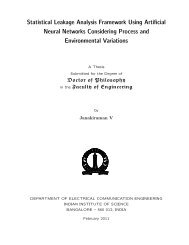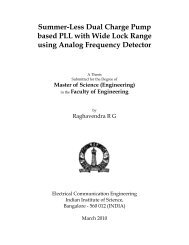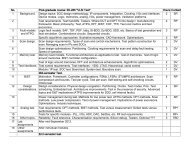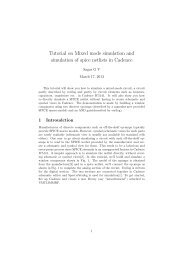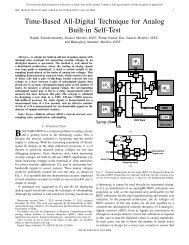NoC design and optimization for Multi-core media processors
NoC design and optimization for Multi-core media processors
NoC design and optimization for Multi-core media processors
Create successful ePaper yourself
Turn your PDF publications into a flip-book with our unique Google optimized e-Paper software.
AbstractiiiThere exists an optimum degree of pipelining which minimizes the energy-delay productof the link. In a 2D Torus when the longest link is pipelined by 4 stages at which pointleast latency (1.56 times minimum) is achieved <strong>and</strong> power (40% of max) <strong>and</strong> throughput(64% of max) are nominal. Using frequency scaling experiments, power variations of upto 40%, 26.6% <strong>and</strong> 24% can be seen in 2D Torus, Reduced 2D Torus <strong>and</strong> Tree based <strong>NoC</strong>between various pipeline configurations to achieve same frequency at constant voltages.Alsoinsomecases, wefindthatswitchingtoahigherpipeliningconfigurationcanactuallyhelp reduce power as the links can be <strong>design</strong>ed with smaller repeaters. We also find thatthe overall per<strong>for</strong>mance of the ICNs is determined by the lengths of the links needed tosupport the communication patterns. Thus the mesh seems to per<strong>for</strong>m the best amongstthe three topologies (Mesh, Torus <strong>and</strong> Folded Torus) considered in case studies.The effects of communication overheads on per<strong>for</strong>mance, power <strong>and</strong> energy of a multiprocessorchip using L1, L2 cache sizes as primary exploration parameters using accurateinterconnect, processor, on-chip <strong>and</strong> off-chip memory modelling are presented. On-chip<strong>and</strong> off-chip communication times have significant impact on execution time <strong>and</strong> the energyefficiency of CMPs. Large caches imply larger tile area that result in longer inter-tilecommunication link lengths <strong>and</strong> latencies, thus adversely impacting communication time.Smaller caches potentially have higher number of misses <strong>and</strong> frequent of off-tile communication.Energy efficient tile <strong>design</strong> is a configuration exploration <strong>and</strong> trade-off study usingdifferent cache sizes <strong>and</strong> tile areas to identify a power-per<strong>for</strong>mance optimal configuration<strong>for</strong> the CMP.Trade-offs are explored using a detailed, cycle accurate, multi<strong>core</strong> simulation frameworkwhich includes superscalar processor <strong>core</strong>s, cache coherent memory hierarchies, onchippoint-to-point communication networks <strong>and</strong> detailed interconnect model includingpipelining <strong>and</strong> latency. Sapphire, a detailed multiprocessor execution environment integratingSESC, Ruby <strong>and</strong> DRAMSim was used to run applications from the Splash2benchmark (64K point FFT). Link latencies are estimated <strong>for</strong> a 16 <strong>core</strong> CMP simulationon Sapphire. Each tile has a single processor, L1 <strong>and</strong> L2 caches <strong>and</strong> a router. Differentsizes of L1 <strong>and</strong> L2 lead to different tile clock speeds, tile miss rates <strong>and</strong> tile area <strong>and</strong> hence




